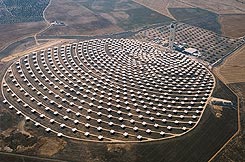
By John Addison (5/28/09).
The Solar Electric Power Association (SEPA) whose membership includes 110 utilities issued a new report – “2008 Top Ten Utility Solar Integration Rankings” – which identifies the utilities in the U.S. that have the most solar electricity integrated into their portfolio.
The report demonstrates that the utility segment is making a major investment to increase the amount of solar energy in power portfolios, with many utilities doubling the amount of solar power in their portfolio in just one year. The installed solar capacity of the top ten ranked utilities rose 25 percent in a tough economy, from 711 megawatts to 882 megawatts.
The Top 10 Utilities in cumulative megawatts installed represent six states stretching from California to New York:
#1 Southern California Edison(EIX) – CA (441.4MW)
#2 Pacific Gas & Electric (PCG) – CA (229.5)
#3 NV Energy – NV (77.9)
#4 San Diego Gas & Electric (SRE) – CA (49.3)
#5 Public Service of Colorado (Xcel Energy – XEL) – CO (28.5)
#6 LA Department of Water & Power – CA (13.6)
#7 Public Service Electric & Gas Co. – NJ (13.2)
#8 Arizona Public Service Co. – AZ (10.6)
#9 Sacramento Municipal Utility District – CA (10.2)
#10 Long Island Power Authority – NY (7.7)
Although the sunny West Coast dominates this year’s list, other states are coming on strong including Florida, North Carolina, and Florida. Yes, the availability of sunlight is one driver in the expanded use of solar. Other drivers include the retail price of electricity, state government initiatives such as RPS, and cap-and-trade of emission credits.
There are two primary solar technologies, photovoltaic and concentrating solar power. Photovoltaic (PV) technologies utilize a photosensitive material to generate electricity direct from sunlight. PV can also be magnified using mirrors or lenses in low- or high-concentrations known as concentrating photovoltaic technology or CPV. Concentrating solar power (CSP) technologies utilize mirrors or lenses to concentrate sunlight on a point or line and generate high-temperature heat, which is captured to generate electricity in a later process.
Julia Hamm, Executive Director of SEPA, sees strong growth in both PV and CSP. For example, Southern California Edison is planning a massive 1.3GW of CSP with BrightSource. Arizona Power is planning 125MW of PV. Medium- and utility-scale photovoltaic and concentrating solar thermal power projects are adding around 20 billion of dollars worth of investment.
Some European nations that aggressively use wind power, such as Spain and Denmark, have demonstrated that intermittency is quite manageable when renewable energy is less than 20% of the mix. CSP can take the mix much higher by storing energy in liquids like molten salt for delivery when demand peaks.
#5 on the list, Public Service of Colorado (Xcel Energy), is already experimenting with vehicle-to-grid (V2G Report), which will allow the growing population of electric vehicles to provide power to the grid during peak hours. Utilities are experimenting with several forms of large scale grid-storage which will be promising if significant costs are achieved.
Some 30 years ago, solar was dismissed as impractical. Now that PV manufacturing cost is 100 times less than in early days, utilities are taking the lead in the growing demand for solar power.
